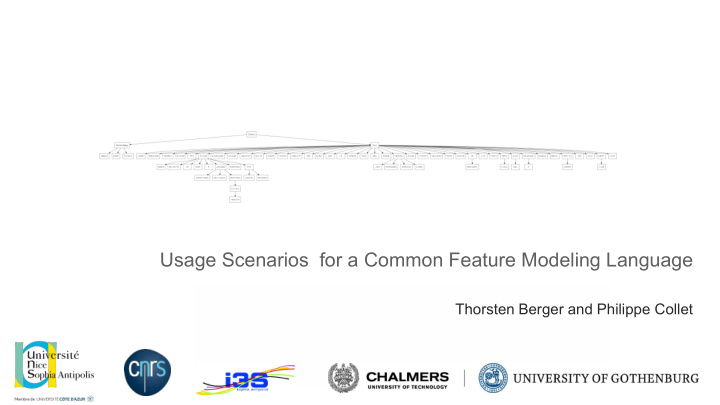



Usage Scenarios for a Common Feature Modeling Language Thorsten Berger and Philippe Collet
feature modeling Feature Oriented Domain Analysis (FODA) by Kang et al. 1990 FODA succeeded for its simplicity searching for “feature modeling“ alone yields 13,500 results on google scholar 2 (C) Thorsten Berger, Chalmers | University of Gothenburg
Methodology initial meeting at SPLC’18 in Gothenburg agreement on scenario-driven methodology, brainstorming first set of 15 usage scenarios (voted) two researchers assigned (typically, one writing, another proofreading) scenarios described mid September to mid October 2018 survey to evaluate scenario clarity and usefulness created by David distributed via the initiative’s mailing list 15 responses analysis and refinement upon results, refined and extended the scenario also removed and added (very) few 3
14 refined scenarios scenario: name short description example notes (e.g., specific requirements or open questions) 4
What is the usefulness/priority of the scenario? usefulness/priority 1 (not useful at all), 2 (not useful), 3 (more or less), 4 (useful), 5 (very useful). 5
a preliminary roadmap idea: incrementally build the language to make progress second evaluation, of the refined and extended usage scenarios? re-open the discussion about further scenarios that need to be realized e.g., collaborative creation of feature models discussed at workshop, but not formulated devise first set of features from scenarios perceived most useful: Exchange, Storage, Domain Modeling, Teaching and Learning, Mapping to implementation, Model generation, Benchmarking, Analyses 6
7
8
9
a preliminary roadmap Exchange: a simple textual language seems to meet the scenario’s challenges Storage: realize using a common language workbench (e.g., Eclipse EMF with Xtext) or YAML/JSON technology Domain Modeling: capability to incrementally and partially create a feature model is needed Teaching and Learning: simplicity of the language for writing, editing, and configuring should be kept in mind. Model generation, Benchmarking, and Analyses could be easy to meet if propositional feature models chosen as first level of expressiveness Mapping to implementation not easy scenario to meet still open problem, depending on types of artifacts and variability realization techniques 10
discussion design and implement first kernel of functionalities at same time? Implementation enables scenario validation automatically (continuous integration) for implementation, important design decisions: fluent API external or internal DSL, or clever combination validation use scenario Analyses with its first example (dead-feature detection) as first validation discuss other useful analysis scenarios similarly, use the Benchmarking scenario? (first example is a benchmark for dead-feature computation) initial kernel of a language strip down Clafer into language levels? 11
paper with detailed scenario descriptions: http://www.cse.chalmers.se/~bergert/paper/2019-modevar-fml-scenarios.pdf survey about refined scenarios (only 5 answers so far) https://forms.gle/HaG2reNZwWKCMQzm7 12
also thanks to: Mathieu Acher, Maurice Ter Beek, David Benavides, José A. Galindo, Rick Rabiser, Klaus Schmid, Thomas Thüm, and Tewfik Ziadi Usage Scenarios for a Common Feature Modeling Language Thorsten Berger and Philippe Collet <thorsten.berger@chalmers.se>, <philippe.collet@univ-cotedazur.fr> 13
Recommend
More recommend